Review for Hidamari Sketch: Series 1 Collection
Introduction
A few reviews ago, I offered the opinion that the UK anime scene was either focused on the here and now when it comes to anime, or the recent phenomenon of the license rescue for some vintage classic titles, and everything in-between tended to slip through the cracks. It seems that I was talking out of my proverbial, as for the third title in quick succession, MVM are releasing a show that’s over five years old now, for the first time in the UK. This time it’s Hidamari Sketch. I had a brief dalliance with the fourth season, Hidamari Sketch Honeycomb, when it streamed to the UK, and even when taken out of context (I haven’t seen the first three seasons) it came as something of a delight. It’s a school setting, slice-of-life show; a genre still owned by Azumanga Daioh, but Hidamari Sketch comes from the visual powerhouse of Studio SHAFT, from the character designer of Madoka Magica and has gathered a fervent fanbase. The last slice of life school comedy that I saw from SHAFT was Pani Poni Dash, but Hidamari Sketch is a lot mellower, a lot less anarchic. I’ve been looking forward to seeing how the series started, and while I’m reviewing the DVD, it’s worth noting that MVM are also releasing it on Blu-ray in the UK.
Hidamari Sketch is a slice of life show, random vignettes in the lives of four girls who together attend the Yamabuki art school. Yuno and Miyako are first years, Sai and Hiro are second years, and all four live at the Hidamari Apartments, directly opposite their school. One of their teachers is the flamboyant Miss Yoshinoya, who loves to cosplay for her class, something the elderly principal of the school frowns on. The show follows the group of friends as they move towards their dreams of becoming artists.
MVM present 12 episodes, plus 2 OVA Specials across two DVD discs thus.
Disc 1
1. January 11th: Winter Collage
2. August 21st, Japan’s Summer
3. June 17th... Or An Indian
4. May 18th: The Singing Shortcake
5. February 13th: Heart and Body
6. July 14th: Cool and Comfy
7. October 12th: Stormy Drying Agent
Disc 2
8. March 13th: 3% Of Hope
9. September 4th: The Wolf of the Shinjuku Backstreets
10. November 3rd: Her Highness Yuno
11. April 28th: A Round Cabbage
12. December 25th: Goodbye Ume-Sensei
OVA 1. August 11th: Put Her Back Where She Was
OVA 2. November 27th: Is It Love?
Picture
Hidamari Sketch is presented on these DVD discs in 1.78:1 anamorphic NTSC format. It should be mentioned once more that those of an HD persuasion will also be able to get the show on Blu-ray on the day of release. The image is clear and sharp throughout, with strong and consistent colour reproduction, and given SHAFT’s particular style of animation, a minimum of digital banding, even on DVD. I did note one frame of compression in episode 8, but that’s about the only nit I have to pick with the transfer.
This is a SHAFT animation, and it bridges the gap between the all out visual gag-fests of Pani Poni Dash and Negima, with the more restrained storytelling of Bakemonogatari and Madoka Magica. With Hidamari Sketch, the animators stick to a set style, a restrained and pastel palette, and avoid trying anything and everything to make a visual impact. But the use of gags, short-cuts and visual tricks is still more prevalent. One example is Yuno’s hairclips. She wears her hair tied back with cross shaped hairclips, and it isn’t long before the animators simply put a cross on screen when she’s speaking, the same with Hiro’s hair buns, and Sae’s glasses. It’s generally an enjoyable viewing experience the further you go into it, but it takes a while to get used to the show’s animation style.
Sound
Hidamari Sketch gets a DD 2.0 Japanese audio track with optional English subtitles. Well, I say optional, but as this is a subtitle only release, only the most fluent of Japanese speakers will turn them off. There’s no problem with the audio, the characters are ideally cast, the dialogue is clear, the music suits the show, and the stereo gives the show a decent amount of presence. I have a few nitpicks with the subtitles though, which are accurately timed, and suffer only a couple of typos. You have to remember for one thing that the translation is into a US idiom, which is why I was scratching my head when they kept calling caterpillars, worms. Another thing is the occasional looseness of translation. One running joke in the show is Miya questioning Sae’s gender, and in episode 4, a funny new-half/new quarter gag is politically corrected in the subtitle translation to something completely unfunny. It doesn’t happen too often, but it does stand out when it occurs.
Extras
MVM are once again simply porting over Sentai’s discs, so there’s no difference in menus or content. These menus are static by the way. Each episode is followed by a translated credit reel.
Disc 1 has further Sentai trailers for plenty of shows that missed the UK boat. You can see promos for Little Snow Fairy Sugar, Glass Mask, Yozakura Quartet, Special A, and You’re Under Arrest: Fast and Furious, although Clannad After Story did get a UK release in the end.
Disc 2 offers the textless credit sequences, and it also has the two bonus episodes listed above.
Conclusion
My initial impression of the first season of Hidamari Sketch was that it wasn’t as funny as the fourth season, and given that I watched Hidamari Sketch Honeycomb out of context, with no exposure at all to the rest of the franchise, didn’t bode well. After all, Hidamari Sketch Honeycomb has a larger cast of characters, and far greater opportunities for comedy because of that. I needn’t have worried though, as this is the first series, and the whole point here is to introduce this world, establish the characters and the relationships between them, and get people used to the format of the show, the style of the comedy. It’s like The Fast Show. I didn’t laugh at the first episode I watched, only smirked at the second, but by the fourth or fifth, it was the funniest thing on TV for me. Hidamari Sketch takes a tad longer to settle in, but by the second disc, I had engaged with the show, got acquainted with the characters, and was enjoying SHAFT’s quirky animation style instead of being distracted by it.
Hidamari Sketch is of that particular slice of life genre that’s made to relax to. It has even less of a story arc than other similar, school set slice of life shows such as Azumanga Daioh and K-On, and at its most frivolous, it’s really just about basking in the joy of four friends interacting, just talking about their days, the world, whatever triviality springs to mind. It’s just people having a natter, but the secret really is in the scripting. Overhear people in real life gossiping and it’s the most tedious nonsense imaginable because we don’t relate. The conversations these friends have are interesting, and draw us in as viewers, making us feel less like voyeurs and more like participants. They’re also funny, which is the whole point. These are friends that engage in banter, good-natured teasing, surreal flights of fancy, or just plain silliness. If there are small story arcs in the episodes, or even stretching across the episodes (such as Yuno’s caterpillar/worm), then they too are trivial and emotionally soothing.
The show also has a trick up its sleeve by not showing the episodes in chronological order, yet with characters referring to previous events. It makes you pay greater attention for those few ongoing threads, and you appreciate that light bulb of recognition even more when you figure out what a character might have been talking about four episodes previously. It’s the same kind of structure that made the broadcast version of The Melancholy of Haruhi Suzumiya preferable to the chronological version.
The episodes tend to follow the same structure, beginning and ending with Yuno’s point of view from the moment she wakes up, to the relaxing bath as she ponders the day’s events. And as you can see from the episode titles, we get one random day each month with the friends. Yuno and Miyako are there for their first year at Yamabuki high school, and are living alone for the first time at the Hidamari apartments. Yuno’s the quiet, thoughtful character who in many ways acts as our eyes into this world, while Miyako is brash and outgoing and with a goofy sense of humour. Sae and Hiro are in their second year, also living at the Hidamari apartments, and if anything come across as a married couple. Sae already has a job as a novelist, so she has to juggle her editor’s deadlines with school deadlines, and tends to neglect the niceties as a result. She’s tall, and a little masculine in her personality. Hiro on the other hand is the maternal, caring type (when she isn’t worrying about her weight), and she tends to clean up after Sae, makes sure she eats her meals, and they even bicker on occasion like a married couple.
Other significant characters include their teacher, Yoshinoya-sensei, who in many instances is even more childish than her students. She’s ‘eternally seventeen’, and she loves to cosplay, thinking that she makes a suitable model for her students, though her antics tend to get her into trouble with the headmaster, a man so ancient that he’s constantly trembling, although he can on occasion surprise with a sudden bout of youthful energy. We do meet a few other characters, Sae’s younger sister Chika, the Landlord of the apartments, another student named Natsume (rival to Sae) but generally this series focuses on the four friends.
Hidamari Sketch is a hard show to review if you’re looking for plot details. It adapts a gag manga, and I could fill the page with the bits that I found entertaining and funny, have a paragraph of bits that fell flat, and a paragraph of bits that went over my head. This is after all a show that revels in conversation and dialogue, and not everything translates into English idiom all that well. There are a couple of jokes that do get lost in translation. But generally Hidamari Sketch works very well. It is after all a show about friendship, about the joy of being with like-minded people, and the humour in frivolity, the appreciation of silliness. It’s fun, it’s inconsequential, and it’s therapeutic in the way that it can relax the viewer. It takes a while to get going, but Hidamari Sketch is a delightful comedy, and hopefully the subsequent seasons will be released here too.






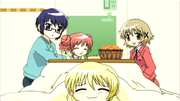








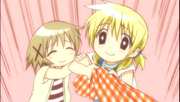
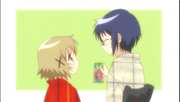

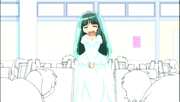






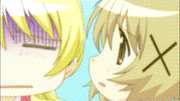

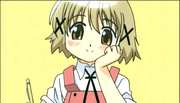


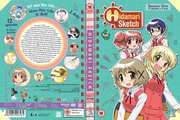






































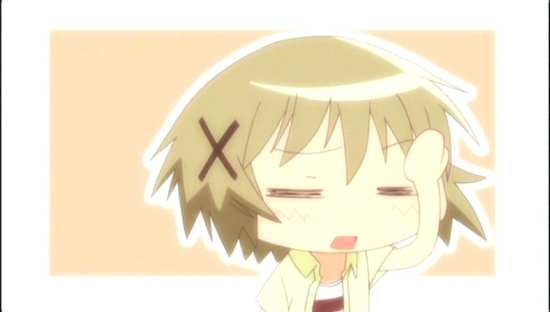
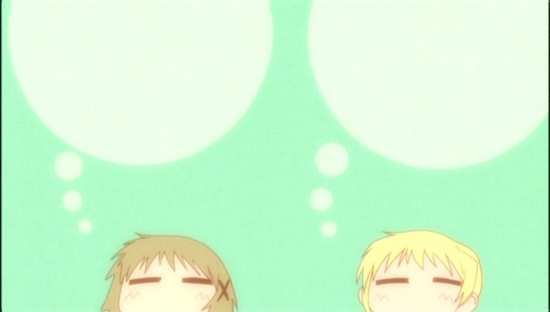


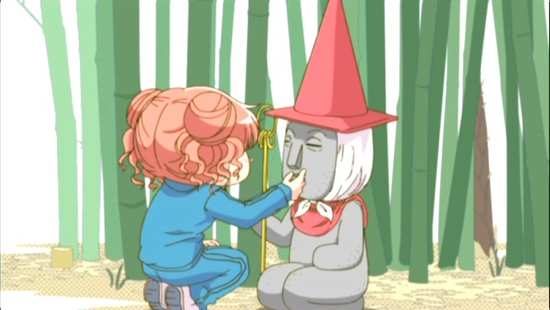


Your Opinions and Comments
Be the first to post a comment!